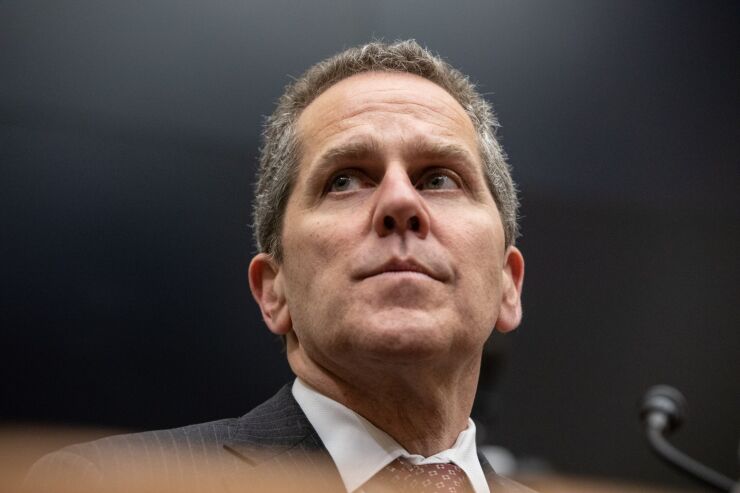
WASHINGTON — Federal Reserve Vice Chair for Supervision Michael Barr expressed confidence that the
Speaking at the Bipartisan Policy Center in Washington on Monday, Barr said the capital adjustments aim to align the U.S. with the Basel III endgame guidelines, which standardize risk-based requirements calculations and add regulatory safeguards, such as requiring large firms to account for unrealized losses in their available-for-sale securities.
He said forthcoming proposals would primarily apply to banks with assets above $100 billion — a threshold that would encompass the three midsize banks that failed earlier this year.
"Even banks of this size can cause stress that spreads to other institutions and threatens financial stability," Barr said.
Barr estimated that the new proposals would require the country's largest banks to hold an additional 2 percentage points of capital, or an extra $2 of capital for every $100 of risk-weighted assets. Barr believes that most banks are already well-positioned to meet these requirements.
"We estimate that banks [not already adequately capitalized] would be able to build the requisite capital through retained earnings in less than 2 years, even while maintaining their dividends," Barr said.
Barr also highlighted the need to update the standards for calculating banks' risk-based requirements to better reflect credit, trading and operational risks. He proposed replacing banks' individual risk estimates with a standardized approach, saying current internal models have inherent deficiencies.
"Banks tend to underestimate their credit risk because they have a strong incentive to lower their capital requirements," he said. "And estimates of credit risk for similar exposures can vary substantially across firms"
In terms of market risk measurement, Barr suggested that the proposed changes would better align market risk capital requirements with actual market risk exposure, while providing supervisors with improved tools. The proposal, he said, would still allow banks to use internal models for capturing complex market risks but would exclude certain hard-to-model risks. Additionally, the proposal would require firms to model risk at the level of individual trading desks for specific asset classes, rather than at the firm-wide level.
Barr also said the forthcoming proposed rule will aim to introduce a standardized model for measuring operational losses. This model would approximate a firm's operational risk charge based on its activities and adjust the charge based on historical operational losses with the hopes of improving risk sensitivity and incentivizing firms to mitigate their operational risks. Barr emphasized that the use of such a standardized model would help reduce the regulatory burden on banks, as they would not need to develop internal credit risk and operational risk models for calculating regulatory capital.
Barr said that in addition to being subject to higher capital requirements, banks will need to change how they calculate unrealized losses. Banks with assets in excess of $100 billion would be required to account for unrealized losses and gains in their available-for-sale securities when calculating their regulatory capital. Barr cited the importance of including these losses in reported capital to avoid triggering market reactions and runs on banks, as exemplified by the events surrounding the failure of Silicon Valley Bank.
"Realizing the losses from these securities, without adequate capital to protect from those losses, was an important part of the set of events that triggered the run on Silicon Valley Bank" he noted. "If the bank had already been required to include those losses in its reported capital, it is less likely that the market and depositors would have reacted the same way."
Barr commended the current stress capital buffer framework but also acknowledged the need for improvements.
"The stress test should be more stressful to adequately prepare banks for unexpected events, and it should evolve to capture a wider range of risks," he indicated.
Additionally, Barr announced regulators' intention to introduce a long-term debt requirement for all large banks.
"[Long-term debt requirements] might have reduced [SVB's] risk of a run by uninsured depositors; and it might have given the FDIC more options to resolve the bank or merge it with a healthy institution," he said. "More long-term debt at SVB would have reduced the cost to the FDIC of its resolution. All of these factors would have reduced the risk of contagion to other banks."
Bank industry trade groups expressed frustration that Barr, in their opinion, did not explore adequately the potential costs banks could incur from such new requirements.
"Remarkably, Vice Chair Barr's 'holistic capital review' apparently did not include any consideration of the cost of capital requirements — costs to economic growth, credit availability, market liquidity or the economy as a whole," Bank Policy Institute President and CEO Greg Baer wrote in a statement shortly after Barr's remarks. "It is thus an atomistic rather than holistic review — a benefit-benefit analysis of capital requirements. We hope that others will take a broader view of the facts and reach different conclusions."
While acknowledging the potential changes in bank activities resulting from increased capital requirements, Barr emphasized that enhanced capital provides long-term durability and resilience. He encouraged banks to view the changes, pursuant to the
Barr also mentioned that in addition to today's announcements on capital, forthcoming regulations on liquidity, interest rate risk, incentive compensation and examiner supervision timeliness are on the horizon.
"It is not a choice between supervision and capital regulation — capital is and has always been the foundation of a bank's safety and soundness," Barr concluded. "While this increase in requirements could lead to some changes in bank activities, the benefits of making the financial system more resilient to stresses that could otherwise impair growth are greater."






